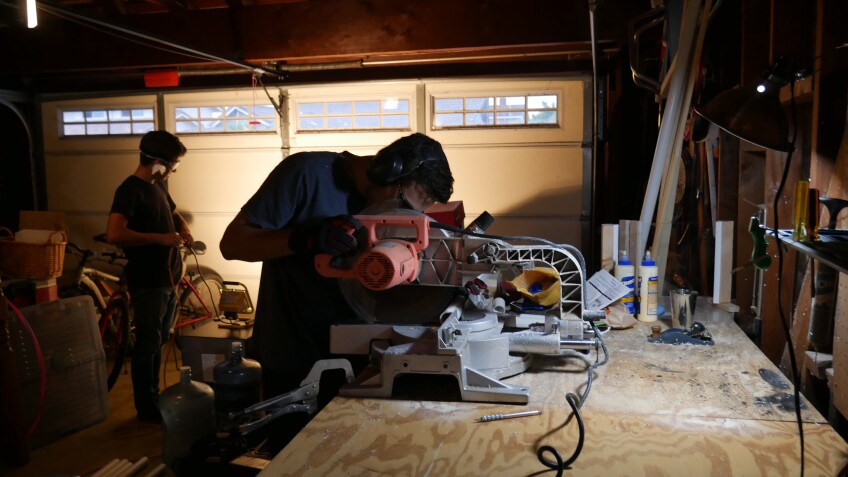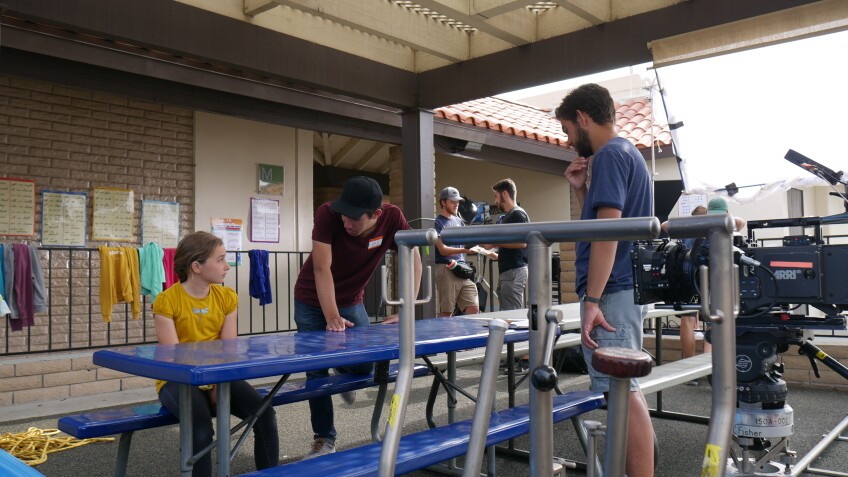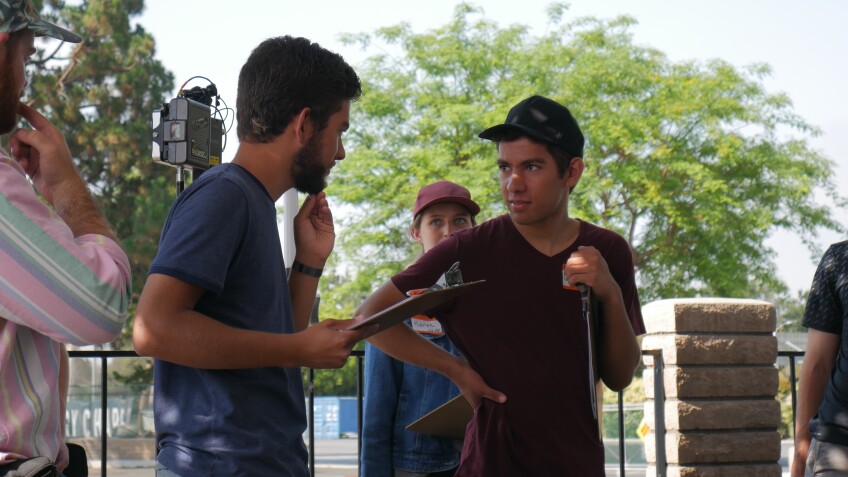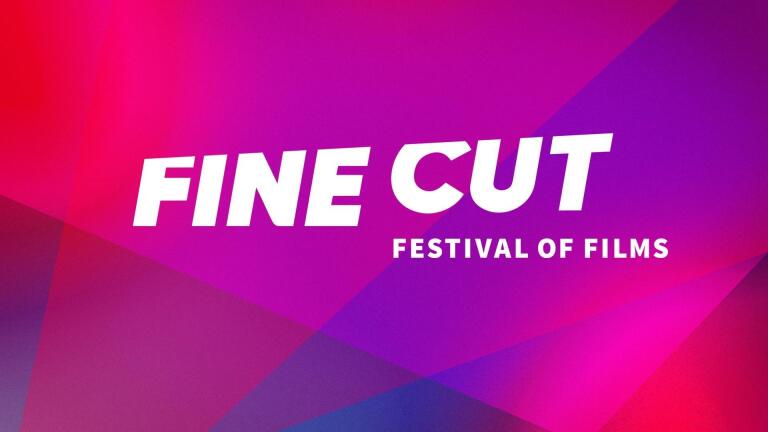These Filmmakers DIY'ed Their Way to Making a Twin Movie — Without Twins

At the beginning of the pandemic, Luke and Ethan Montgomery, twin brothers and juniors in the film program at Biola University, were looking for a project. One day, Luke was watching "Back to the Future Part II" when inspiration struck. The 1989 film pioneered motion-control camera work; to shoot it, ILM developed the VistaGlide, a motion-control dolly system with video playback that made it possible for Michael J. Fox and other actors to play several different characters in the same scene.
Ethan says, "It costs millions of dollars to make this camera rig that could silently do the exact same camera movement over and over again so they could stitch it together on the physical film." With help from their older brother, Schuyler, an engineering student, Ethan and Luke decided to try making a similar dolly at home. Ethan says, "We thought, 'This is so cool!' and it would be so much easier and cheaper to do this with our older brother, who could program it, and some PVC pipe, wood and skateboard wheels."

Luke and Ethan, who make films together under the name Montgomery Brothers, developed an interest in visual effects in sixth grade, when a computer teacher showed them how to use a green screen and a free video editing program. Luke says, "Initially, it was just the cool factor of what we can do with that kind of technology that got us into film." In high school, they became more interested in storytelling. Ethan says, "We've implemented visual effects in our films, only as a tool to tell a story."
For their pandemic project, they wanted to make a movie about twins, so the idea of building their own motion-control camera rig appealed to them. They also had an actor in mind that they wanted to work with — Emery Gordon, a girl from their church — and she wasn't a twin.

Making "Amelia (the Twin)" was challenging in two very different ways. The first was building and controlling the camera dolly. To make it look like the film featured actual twins, they knew they'd have to duplicate many of the shots. Luke explains, "You have to control the camera extremely precisely, and even to a greater degree than we realized when we started. Because even when you have the camera moving at the same time, you're working in 24 frames a second. And even within 1/24th of a second, there can be a difference. We actually had to shoot everything in 60 frames per second, so that there's a shorter window of the possible difference between the two plates."
Rob Bredow, Chief Creative Officer at Industrial Light and Magic, is an alumnus of Biola, so the brothers emailed him for advice. They initially hoped to build something that they could operate like a normal camera on set, then press a button and have it repeat what they had just done. Bredow offered some suggestions on how to improve the process, and they ended up preprogramming each camera move instead.

After making measurements of exactly where the twin characters, Amelia and Jane, would be in the shot, they mocked up the camera movements in their garage. Luke says, "We could run that over and over again to get it right and tweak how fast it's going to accelerate and decelerate, and the overall speed of it, and then see, 'Are there bumps? How can we get rid of those?'" When they switched to a larger camera on set, it threw off the center of gravity of the pan/tilt head, and they had to make even more adjustments.
For the duplicated shots, they used audio tracks to cue Emory on when to say each line. Ethan recalls, "It was a logistical nightmare." Some shots also required a double to play Jane or Amelia. Luke says, "There's a shot where Amelia pushes Jane out of the way, coming out of the bathroom, looking for scissors. That's her pushing a double. But earlier in that shot, you see both of them, so it's motion control — and then there's a second where Jane pops out of frame and comes back in as a double. That was complicated, but kind of fun."
The film was also challenging for the brothers to make on a personal level. Luke says, "There are a lot of technical things we learned, but the biggest things we learned were about finding a story to tell and diving deeper into our personal experience and how that informed our writing."
"We've been asked the question our whole lives, 'What's it like to be twins?'" Ethan says. "Our responses are always just like, 'I don't know, what's it like not to be?" He says it wasn't until they started college that they realized, "Our experience being just like someone else has actually dramatically shaped our life experience and dramatically shaped who we are.'"
They wanted to make a film about that shared experience, but deciding what to say wasn't easy.
Ethan explains, "At first, it was like, 'Oh, we're twins, so we'll make a movie about twins and it'll be educational.'" Then they realized that simply being twins wasn't enough of a reason to make a movie about twins. He says, "We needed to do a lot of self-therapy and realize, 'How has being twins affected our lives? How has it shaped who we are?'"
Luke adds, "It took a really long time to figure out what it really was we wanted to say about it. Writing the film was a lot of self-discovery for us about the things that we've been struggling with our whole lives that we've never really thought about."
Ethan says, "We did not want to admit that we are as similar as we are and that we've been fighting that our whole lives. It took a lot of humility to get there."
Several months into writing "Amelia (the Twin)," all of that introspection paid off, and they found the bigger truth they wanted to share. Luke says, "It's that we've always been pushing against each other, we've always been trying to be different from each other, when the reality is we're so similar. And that's when the script kind of found its way."
We did not want to admit that we are as similar as we are and that we've been fighting that our whole lives. It took a lot of humility to get there.Ethan Montgomery, filmmaker
Early on in the short film, Amelia and her twin Jane sing a sweet, catchy song — "Up and Down" by Justin James Sinclair — as they jump rope during recess. The scene emphasizes the twins' similarities, and it's pulled straight from the filmmakers' lives. Ethan says, "When we were in elementary school, we always sang. One day a week, we'd go to the younger kids' playground, and we would go on the swings and we would sing." At the time, they weren't self-conscious about it at all. He adds, "We'd just sing in front of our whole class just for our own pleasure… I think we both look back on that as an image of our childhood where we just had this pure desire to sing, and we weren't embarrassed about it."
Luke adds, "And we never thought about it as something we did together. It was just something we both liked to do. There was this kind of innocence to that. We both remember the day when our fourth grade teacher said something in class about us singing on the swings, and we were so embarrassed. The class laughed, and we never did that again. We both remember that moment vividly."

"Amelia (the Twin)" is the Montgomery Brothers' most personal project to date. They made it for around $4,000, which they raised on Kickstarter. The film has shown in several festivals, including Dances with Films and Palm Springs ShortFest. Luke says, "That was really fun and a great experience, but to us, the joy of that is people seeing it."
What advice would they give other filmmakers interested in making their own motion-control camera dolly? Luke says, "There's a part of me that says, 'Don't do what we did.' I feel like it takes the rare combination of us as twins, with our experience of visual effects, with an older brother who's an engineering student. Those factors made us capable of overcoming the huge challenge. It was a ton of work." While they aren't eager to do it again, he adds, "We're very proud of having done it and satisfied to have finished it."
As they continue on in film school and after graduation, Luke and Ethan hope to continue collaborating and start making features. Ethan says, "We're not really interested in directing for hire. We want to keep doing what we're doing and telling our own stories."




